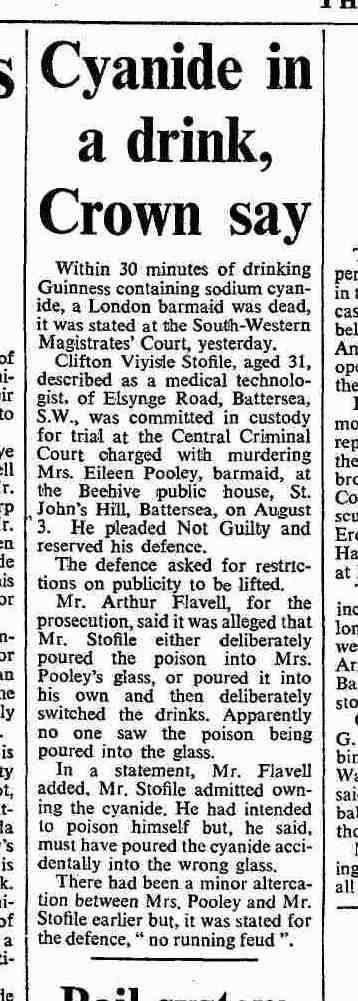As well as covering every new murder in London, we are also trying to expand the database backwards in time to the 19th Century. How do we go about it?
Some cases are so famous that vast amounts of information can be found easily online or in countless books, blogs and newspaper articles (Jack the Ripper, for example).
Many others are mostly forgotten, for a variety of reasons. But even then there is still plenty of information which can be dug up without a vast amount of effort. To illustrate this we looked at an unusual case of cyanide poisoning dating back to 1968.
The search began with an email from a visitor to the site:
Can anyone help me find out case and details of Murder of barmaid in Beehive Public House St Johns Road, Battersea London SW11. The barmaid was named Helen Enright commonly called Eilleen. A customer poisoned her with cyanide. this happened about 40 years ago.
At the time there was nothing in the Google search results for a Helen or Eileen Enright in connection with the Beehive pub in Battersea. The breakthrough came with a search on the Times Archive of newspaper reports between 1785 and 1985.
This revealed that there was a report of a murder case involving an Eileen Pooley at the Beehive pub in the Times of September 6, 1968.
Now we have full names for both the victim and defendant we could start searching other online newspaper archives such as the British Newspaper Archive, or the The British Library‘s online collection of newspapers from the 17th, 18th and 19th Centuries (also available to search at the London Metropolitan Archives and other institutions). Users of the British Library can also access the online archives of the Daily Express and Daily Mirror.
The British Library Newspaper archive at Colindale also has copies of nearly every newspaper ever printed (both the actual paper and on microfilm) which can be examined by anyone with a reader’s ticket.
Another vital source of information (at least for cases dating to prior to 1913) is the Proceedings of the Old Bailey website, which often contains a fascinating amount of information including the evidence given by witnesses.
But for our case, which took place in 1968, the best place to look is at the National Archives in Kew. A search of their online catalogue for Eileen Pooley or Clifton Stofile reveals two files of interest:
1) The case papers of the Director of Public Prosecutions at DPP 2/4566 – unfortunately this file is closed until 2052 because it ‘contains sensitive personal information which would substantially distress or endanger a living person or his or her descendants.’
2) The records of the Central Criminal Court at CRIM 1/4966. This contains the statements of the witnesses and Clifton Stofile himself, together with a plan of the Beehive and photographs of the scene.
All of this information was pulled together for our story Guinness and Cyanide: The tragic death of Eileen Pooley. What was the result of the trial? Read and find out.

I must admit I am bemused at the outrage expressed by the first commenter. This information is on public record, AND is from 1968. There is no salacious speculation, this is simple reportage.
Thanks for the info. Also interesting to read what happens to my grandmother. Thank you.
Why are you bringing this case up you HAVE upset a lot of relations of this Women.
We are sorry to hear that. It was not our intention.